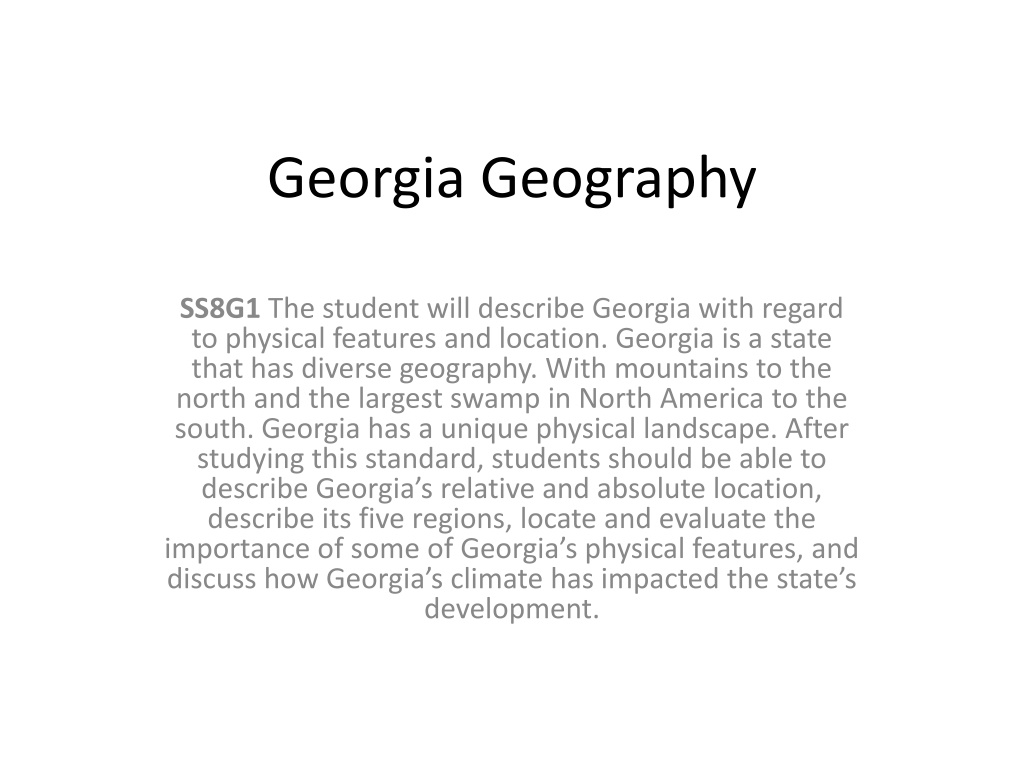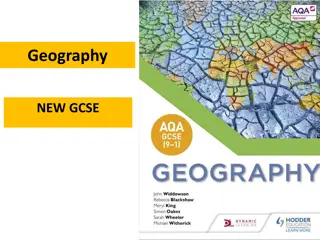Georgia's Diverse Geography and Physical Features
Georgia's geography is characterized by its unique physical features, including mountains to the north and the largest swamp in North America to the south. This state boasts a varied landscape comprising five distinct geographic regions: Blue Ridge Mountains, Valley and Ridge, Appalachian Plateau, Piedmont, and Coastal Plain. Understanding Georgia's relative and absolute location, its importance in terms of physical features, and the impact of its climate on development provides a comprehensive insight into this southeastern state's geographical significance.
Download Presentation

Please find below an Image/Link to download the presentation.
The content on the website is provided AS IS for your information and personal use only. It may not be sold, licensed, or shared on other websites without obtaining consent from the author.If you encounter any issues during the download, it is possible that the publisher has removed the file from their server.
You are allowed to download the files provided on this website for personal or commercial use, subject to the condition that they are used lawfully. All files are the property of their respective owners.
The content on the website is provided AS IS for your information and personal use only. It may not be sold, licensed, or shared on other websites without obtaining consent from the author.
E N D
Presentation Transcript
Georgia Geography SS8G1 The student will describe Georgia with regard to physical features and location. Georgia is a state that has diverse geography. With mountains to the north and the largest swamp in North America to the south. Georgia has a unique physical landscape. After studying this standard, students should be able to describe Georgia s relative and absolute location, describe its five regions, locate and evaluate the importance of some of Georgia s physical features, and discuss how Georgia s climate has impacted the state s development.
Georgias Location SS8G1a. Locate Georgia in relation to region, nation, continent, and hemispheres.
Hemisphere (Globally speaking) Georgia is located in the Western Hemisphere. Georgia is located in the Northern Hemisphere.
Continent Georgia is located on the continent of North America.
Nation Georgia belongs to the United States of America.
Region Georgia is located in the Southeastern part of the United States.
Label your maps 1) On your map of the Northern Hemisphere color North America green. 2) On your map of the Western Hemisphere color North America green. 3) On your map of the United States of America color Georgia green. 4) On your map of the United States of America label the states that border Georgia. [AL, FL, SC, NC, and TN]
Georgias Five Geographic Regions SS8G1b. Describe the five geographic regions of Georgia; include the Blue Ridge Mountains, Valley and Ridge, Appalachian Plateau, Piedmont, and Coastal Plain.
The Blue Ridge Region Located in the Northeastern portion of the state Home to Georgia s largest mountains Brasstown Bald (highest peak in Georgia) Southern most point on the Appalachian Trail Includes the city of Dahlonega, site of America s first gold rush In the past the primary industry was mining.
The Blue Ridge Region Today the primary industry is tourism Receives the most precipitation in the state with over 80 inches of rain a year Is the starting point of most of Georgia s rivers
The Valley and Ridge Region Characterized by low open valleys and narrow ridges Traditionally a mining region with the valleys used for agriculture Cities: Cartersville Calhoun Dalton known for textiles and carpet
The Valley and Ridge Region Historically this region was a major battle ground during the Civil War Major transportation route between Georgia and Tennessee
The Appalachian Plateau Located in the northwestern corner of the state Smallest region Sometimes called TAG region because it is where Alabama, Tennessee, and Georgia all connect at one point. Includes all of Dade County and part of Walker County
The Appalachian Plateau Has many scenic areas and is the location of Cloudland State Park. As with the other mountainous areas of Georgia, mining was an important economic activity in the region. Coal was the most important product. Agriculture is limited due to poor soil.
The Piedmont Region The Piedmont region is in the middle of the state and is the most populous of the five regions. With over 4.5 million people, almost one-half of Georgia s population lives in the region. Most of Georgia s most important cities are located in the region including Athens, Atlanta, Augusta, and Macon.
The Piedmont Region We live in the Piedmont region. Due to these urban centers, manufacturing is important in the region, though agriculture, primarily in the form of poultry, is also a significant enterprise in the region. In addition, due to the large amount of granite found in the region, mining has been important.
The Piedmont Region Stone Mountain may be the most obvious example of the large amount of granite that can be found in the region, but the town of Elberton is known as the Granite Capital of the World .
Coastal Plain Region The largest region in Georgia is the Coastal Plain. The inner Coastal Plain is the agricultural heartland of the state. In this region peaches, peanuts, cotton and the famous Vidalia onions are important crops.
Coastal Plain Region The Outer Coastal Plain is the home of Georgia s oldest city, Savannah, which was founded in 1733. Due to the abundance of pine trees in the region, naval stores were an important industry in the state. Today, the trees are used in pulp and paper production.
Coastal Plain Region Baxley, Georgia is the only naval stores producer in the nation today. With its location on the Atlantic Ocean, tourism, shipping, and seafood are all important industries in the region.
Key Physical Features SS8G1c. Locate and evaluate the importance of key physical features on the development of Georgia; include the Fall Line, Okefenokee Swamp, Appalachian Mountains, Chattahoochee and Savannah Rivers, and barrier islands
The Fall Line The Fall Line is a natural boundary that separates the Piedmont and the coastal regions. Due to the drop-off of the hilly Piedmont region into the flat Coastal Plain, the waterfalls found on the fall line caused many rivers in the area to be difficult to navigate.
The Fall Line However, the waterfalls did offer sources of water power and many mills were located on the fall line. Many of Georgia s most important cities such as Columbus, Macon, and Augusta were located on the fall line due to their location as the last navigable upstream points in the state.
The Okefenokee Swamp The Okefenokee Swamp covers 700 square miles and is the largest freshwater swamp in North America. Located in southeastern Georgia, the swamp can be found in four Georgia counties (Charlton, Ware, Brantley, and Clinch).
The Okefenokee Swamp Native Americans lived in the swamp dating back to the Archaic period. The Choctaw Indians gave the swamp its name which means land of the trembling earth .
The Okefenokee Swamp The most famous Indian tribe that lived in the swamp was the Seminole, which fought two wars against the United States in the Okefenokee area. White families began settling in the area in 1805.
The Okefenokee Swamp From 1910 until 1937, before Franklin Roosevelt established 80% of the Okefenokee as a wildlife refuge, the swamp was a major source of timber. Now, protected by the federal government, hundreds of animal species live in the area, the most well known being the American alligator.
The Appalachian Mountains The southernmost point of the Appalachian Mountains is located in Georgia. Georgia s highest peaks are in the Appalachian Mountain ranges and they can be found in the three mountain regions.
The Appalachian Mountains In the southern states, these mountains are often called the Blue Ridge due to the blue haze that appears around their peaks. Long ago, the Appalachians were some of the tallest mountains in the world, though millions of years of erosion have weathered them tremendously.
The Appalachian Mountains Today, the highest peak in Georgia is Brasstown Bald, which has an elevation of over 4700 feet above sea level. In comparison, the highest peak in the continental United States is Mt. Whitney at 14,500 feet.
The Chattahoochee River The Chattahoochee River begins its journey to the Gulf of Mexico in the Blue Ridge Region of the state and forms part of the boarder between Alabama and Georgia. Native Americans long used the river as a food and water source, as did Georgia s European settlers.
The Chattahoochee River Due to the Fall Line, The Chattahoochee becomes difficult to navigate between the Piedmont and Coastal Plain regions, though river traffic was important during the 1800s from the Gulf of Mexico to the city of Columbus.
The Chattahoochee River Today, the Chattahoochee is used primarily as a water source for the millions of Georgians living in the Piedmont are, though the river is also used for industry and recreation as well.
The Savannah River The Savannah River forms the boarder between Georgia and South Carolina. One of Georgia s longest waterways, the Savannah River begins in Hart County, forms Lake Hartwell, and then flow to the Atlantic Ocean.
The Savannah River The river has been a source of water, food, and transportation for thousands of years. Paleo Indians lived around the river and Spanish explorer Hernando De Soto was the first European to cross it.
The Savannah River James Oglethorpe chose a site 18 miles upriver to create Georgia s first city, Savannah. Today, the river is navigable for over 200 miles between the cities of Savannah and Augusta.
The Savannah River In addition to shipping, the river is used as a major source of drinking water for Savannah and Augusta, to cool two nuclear power plants in South Carolina, and to generate hydroelectric power.
The Barrier Islands The Barrier Islands, also known as the Sea Islands or Golden Isles, are a chain of sandy islands off the coastline of Georgia. These islands protect the mainland from wind and water erosion.
The Barrier Islands There are 14 Barrier Islands off Georgia s coast including Tybee, St. Simons, Jekyll, and Cumberland. Some of the islands, such as Cumberland, are wild life refuges and are nation or state parks.
The Barrier Islands Others, like St. Simons, have been developed and three (Little Cumberland, Little St. Simons, and St. Catherine s) are privately owned. People have lived on these islands for thousands of years.
The Barrier Islands Indians lived on them in the 1500s, the Spanish set up missions there. During the Colonial and Antebellum periods, plantations were set up on the island to grow products such as rice and indigo.
The Barrier Islands Today, the islands are mainly tourist and recreation destinations through the fishing and paper industries are still important economic enterprises.
Georgias Climate SS8G1d. Evaluate the impact of climate on Georgia s development.
Georgias Climate Georgia has a humid subtropical climate with hot summers and mild winters Mountainous area tend to be cooler than the rest of the state Georgia usually has a large amount of precipitation throughout the year and ranges from 45 to 75 inches per year depending on the area, but receives very little snow fall.
Georgias Climate Georgia is prone to tornadoes and often feels the effects of hurricanes, though the state has not been hit directly since 1898.

























